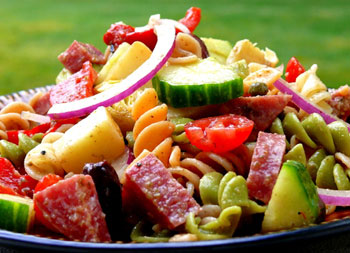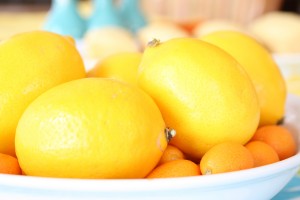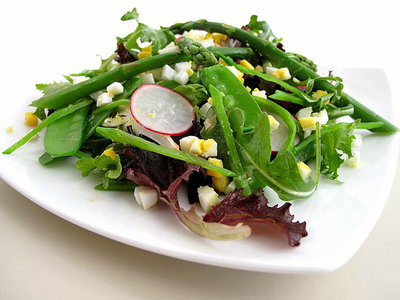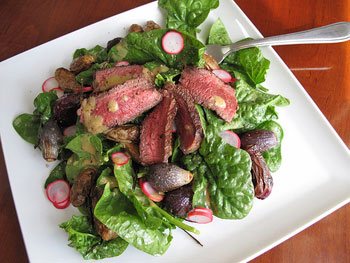 Who doesn't love a good tangy pasta salad? I have tried many, many recipes over the years and I have to say I like the idea of antipasto meets pasta salad.
Who doesn't love a good tangy pasta salad? I have tried many, many recipes over the years and I have to say I like the idea of antipasto meets pasta salad.
Every bite is something different, I love that; crunchy cucumbers, salami, artichoke hearts, kalmata olives and especially the smoked mozzarella. It's quite the yum factor.
This salad is best when made and dressed a day ahead so the flavors can marinate. If you don't have the time to do that, adding a generous splash of red wine vinegar just before serving gives the salad the same bright, tangy flavor.
Make it now or for an upcoming picnic. You will love it.
Spring
Spring
Meyer Lemon Tea Cake
 Spying bright yellow Meyer lemons in the refrigerated produce case at my local natural food co-op never fails to give me a lift. This occurrence usually takes place in March, my least favorite month of the year in northern Minnesota with its dull gray skies, dirty slush, and sometimes, snowstorms that, by this time, no one wants to experience.
Spying bright yellow Meyer lemons in the refrigerated produce case at my local natural food co-op never fails to give me a lift. This occurrence usually takes place in March, my least favorite month of the year in northern Minnesota with its dull gray skies, dirty slush, and sometimes, snowstorms that, by this time, no one wants to experience.
I grabbed several Meyer lemons last week, brought them home and arranged them in a shallow white bowl with the kumquats that also came home with me.
After enjoying their burst of brightness in my kitchen for a couple of days, I knew it was time to use them up. I was ready to make some little tea cakes, tiny loaves infused with the juice of Meyer lemons.
Spring Salad with Asparagus and Snow Peas
 With each and every passing day we're just a little bit closer to spring. I know I can't wait to find delicate green vegetables at the market any time now. I just came back from a trip to San Francisco and as always, whenever I visit a city, I make sure to stop by the local farmers' market. I was so impressed to see that on the West coast they already have bright green asparagus, among many other spring vegetables. Asparagus is really the harbinger of spring. Just like those early crocuses, asparagus bursts out of the ground with an eagerness to embrace spring.
With each and every passing day we're just a little bit closer to spring. I know I can't wait to find delicate green vegetables at the market any time now. I just came back from a trip to San Francisco and as always, whenever I visit a city, I make sure to stop by the local farmers' market. I was so impressed to see that on the West coast they already have bright green asparagus, among many other spring vegetables. Asparagus is really the harbinger of spring. Just like those early crocuses, asparagus bursts out of the ground with an eagerness to embrace spring.
Here on the east coast, our spring vegetables haven't yet sprung, but we do have asparagus from California. I couldn't help myself when I found a bunch of beautiful pencil-thin asparagus at the supermarket just the other day. I was inspired by the many wonderful salads I had on my trip to create a recipe of my own that encapsulates the season of renewal.
Start the recipe by blanching the asparagus and snow peas. This step brings out their brighter green color and makes them more tender. I like to chop half the asparagus and slice half the snow peas for the salad. The remaining whole stalks and pea pods are perfect for garnishing. The lemon vinaigrette adds a sharp wintry note and features minced shallot, which has been mellowed from a soak in vinegar. This salad would make a great appetizer before a spring-themed dinner party.
Spring Steak Salad
 Spring brings many colorful bounties, but the best of the season comes in green. This time of year farmers' markets are brimming with tender, young vegetables. That's why my friend Caroline and I decided to take a trip to the Union Square Greenmarket this past week to see what dish we could create together.
Spring brings many colorful bounties, but the best of the season comes in green. This time of year farmers' markets are brimming with tender, young vegetables. That's why my friend Caroline and I decided to take a trip to the Union Square Greenmarket this past week to see what dish we could create together.
With all the beautiful salad greens available at the market, we naturally decided upon making a salad. After browsing all the produce to see what was the freshest and most appealing, we found some beautiful spinach for our base. We also gathered baby fingerling potatoes, baby red onions, and radishes. Caroline had the perfect idea, to flash pickle the radishes. And for a lean protein, I suggested a steak, which we picked up at the nearby Whole Foods Market. Once we had all our ingredients, we were ready to cook—and eat.
What we achieved was a colorful and healthy salad with a combination of earthy vegetables that encapsulated the flavors of spring.
Bunny Love
 Chances are you didn't buy a bunny for your child this Easter. I know this because according to The Humane Society, sales of bunnies are down this year. That's a good thing, since many American kids fervently love their bunnies until the Tuesday after Easter.
Chances are you didn't buy a bunny for your child this Easter. I know this because according to The Humane Society, sales of bunnies are down this year. That's a good thing, since many American kids fervently love their bunnies until the Tuesday after Easter.
So that got me thinking... since fewer bunnies were purchased this Easter, there must be lots of extra carrots around. And what better way to use up carrots than in carrot cake muffins?
These muffins are a tasty collision between Morning Glory Muffins and classic carrot cake. The sweetness of the grated carrots, crushed pineapple, plump raisins and toasty coconut is balanced by earthy walnuts and spicy cinnamon and vanilla. Since carrot cake cannot be eaten without cream cheese, each muffin is topped with a heavy drizzle of pineapple cream cheese frosting that's good enough to eat by the spoonful. I know.
More Articles ...
Welcome to the new One for the Table ...
Our Home Page will be different each time you arrive.
We're sure you'll find something to pique your interest...


